Video Transcription
What’s up y’all!
As you’re planning out your marketing for the year ahead, you might have a couple of questions popping into your mind. You might be asking, how the heck am I going to reach my goals?
You might even be asking what are your goals as a real estate agent or an investor?
What I’m going to be walking through in this video is a simple five-step process, I use it here at our company, and I suggest you use it as an investor and agent as well, to plan out exactly what you need to do in your marketing in the year ahead to be able to reach your goals.
The cool thing about this is, a lot of people, they’ll look at the goals, write a goal number down, it might be an income goal, it might be a deal number goal, and then you pull back and you say, what are the things that are going to help me get there?
You might write down a few different projects, and I ran my businesses like this for years. I’d have a goal, and I’d go to the whiteboard and I’d say, what are some of the cool, exciting, fun things I might need to do this year?
I’d write them down and then that would be my plan. The thing I would forget to do is what I’m going to teach you today, which is mapping down to your marketing channels, so you have an exact clear, ABC step-by-step plan to reach your goals in a fail-safe way.
As soon as I started deploying this in my own businesses and teaching other investors and agents how to do it as well, you start to get more clarity on your plan.
The cool thing is, I actually did a podcast on this, the cool thing is this becomes your strategy. The definition of a strategy basically, is a strategy is as much what not to do, as it is what to do.
What we’re going to be diving into here on my iPad, is we’re going to show you exactly what you should do, so you can say no to so many other things in this year ahead. Work less, gain more freedom, make a greater impact.
Let’s dive into the iPad now.
The first thing I want you to do here is, there are five steps.
The first step is we’re going to set your goal, and if you have to pause this video throughout, as you’re doing your annual planning, or if you’re watching this sometime in the midyear, amazing.
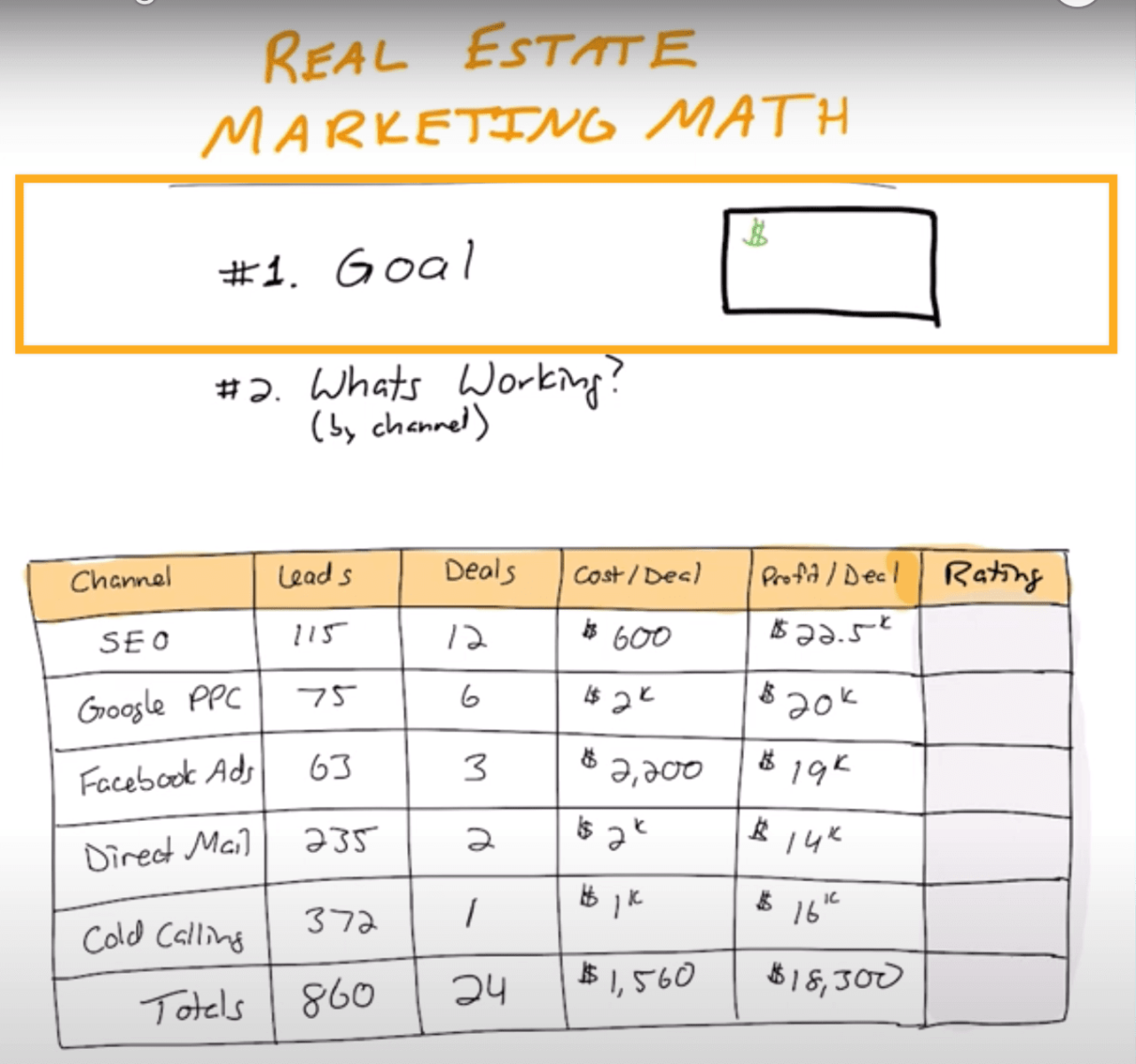
You can still do the same thing if you’re not clear on what you need to do in your marketing to reach your goals as an investor or an agent.
The first step is setting your goal.
Okay, we’re going to pick an income goal, because deal numbers don’t really matter if you’re doing a bunch of low volume or low dollar deals versus if you do some high dollar deals.
I always pick an income number because you can map that to the lifestyle that you want, or the freedom or impact you want to make.
Next, we need to ask what is working? This is a big step a lot of people miss… they set a goal and then they just go, hey, what do I need to do next? We need to first ask what’s working.

I’m going to give you a framework in here for exactly how to track and show what’s working in your business in a crazy, crazy, simple way.
Then what we’re going to say is, what’s the difference between where we currently are to the goal that we’re going for?
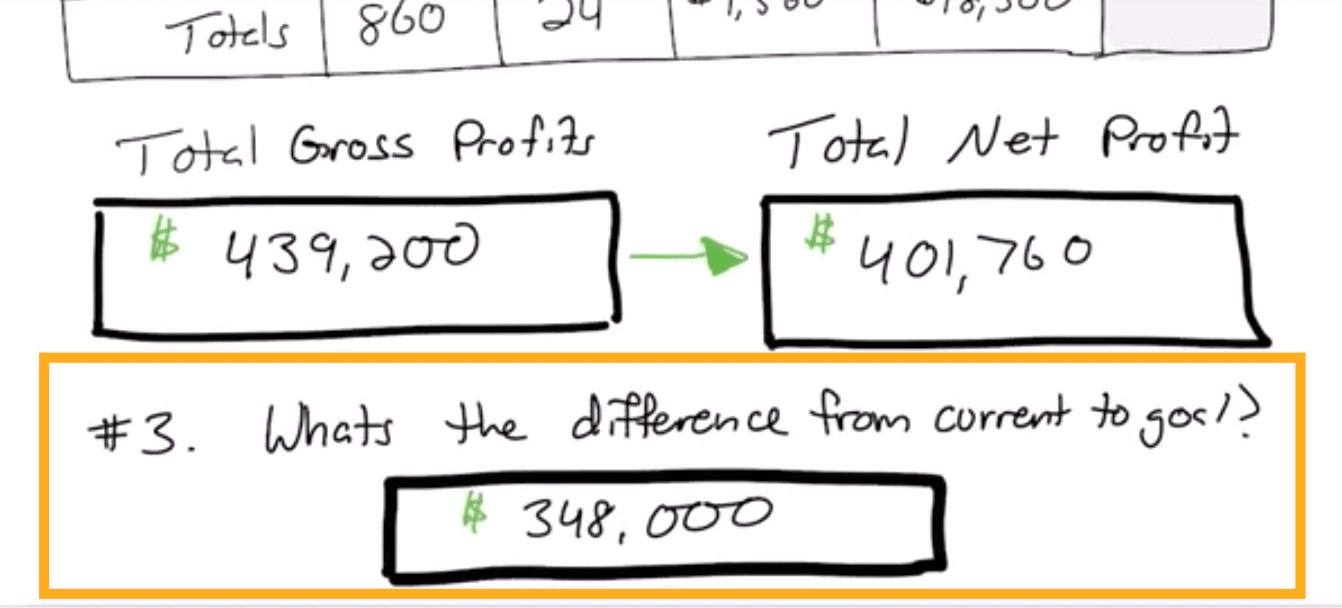
I call it the Delta.
Next, we’re going to say cool, now that we know the difference in what we need to make up, what are the biggest opportunities that we see, the one, two, or three max, to be able to hit our goal.

Then last, we’re going to craft the plan in a really crazy simple one-page thing that you can use each and every quarter.
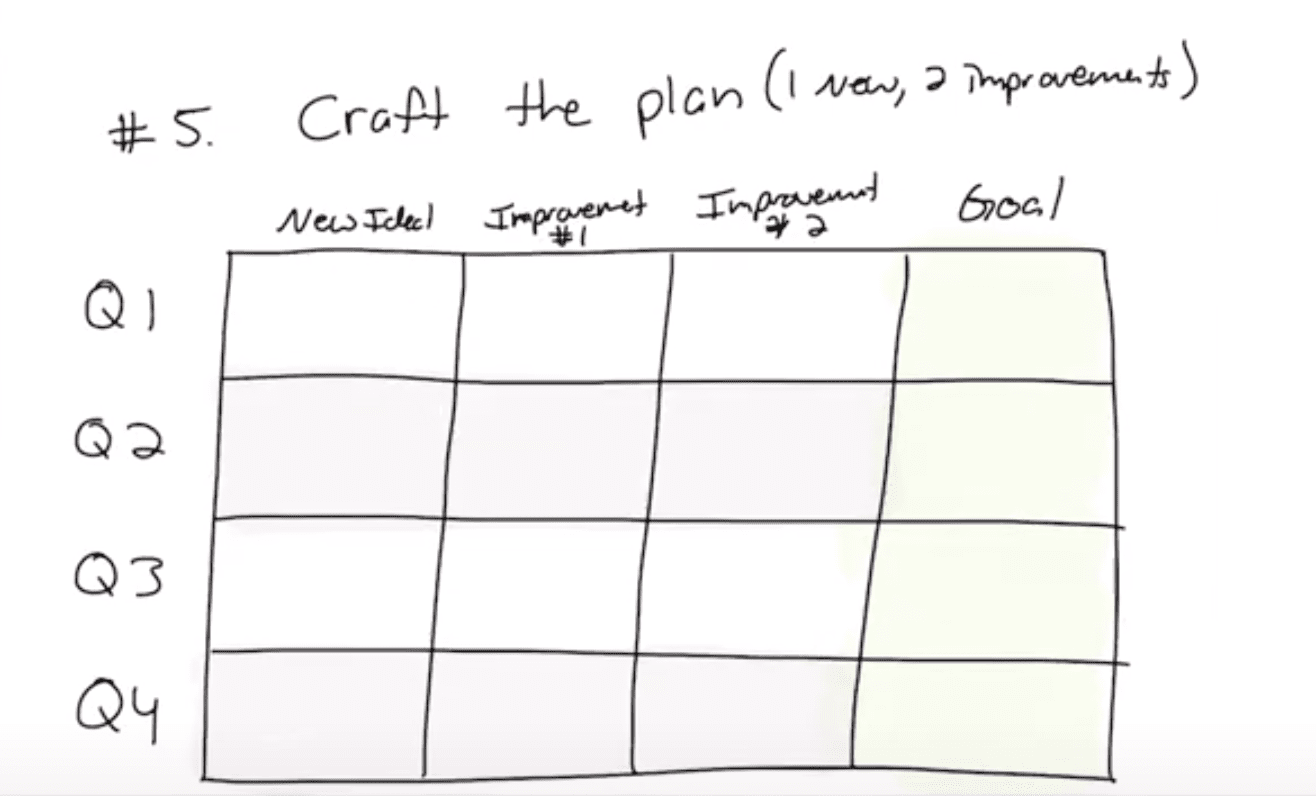
Let’s go back up to the top.
For this example here, I’m going to be working with one of our clients who is an A player. They’ve already started to do some deals. They’re a hybrid agent investor, which is what we specialize here in at Carrot.
The people who have their license, and their investor who can offer cash offers, maybe even flip homes. This person’s been doing deals for two or three years, and they want to get to a $750,000 profit goal.
Okay, so that’s a big goal. If you are trying to get to your first $100,000, it doesn’t matter.
Next what we’re going to do, is I want you to write down every marketing channel that you’re currently using to get leads and to close deals.
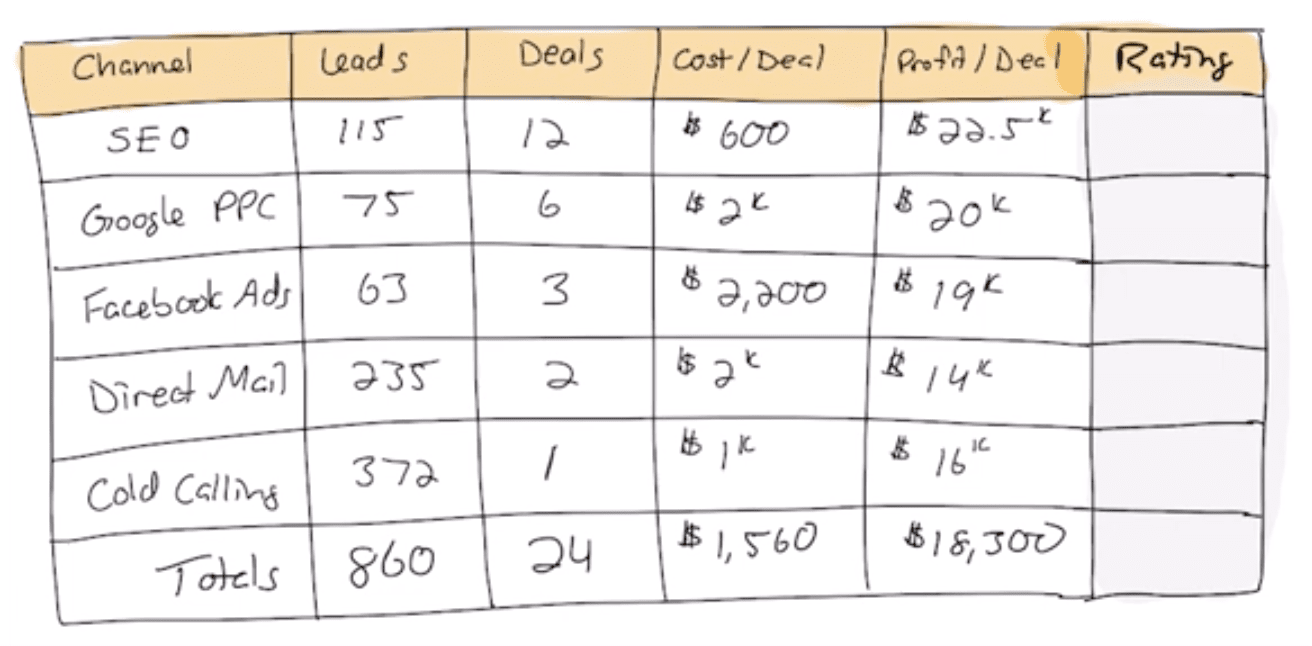
In this example here, you might have SEO or Google pay-per-click, or Facebook Ads, or direct mail, or cold calling, or whatever it’s.
You might be doing referrals as an agent, or you might be big, big, big on cold calling as an investor agent, whatever it is, write down the channels that generated your leads in deals this past 12 months.
If you have to hit pause in this video, go ahead and do it. Write down the channels on the left side and come back.
Next, I want you to pull back into your data. This might be one of those things where you might be going, I don’t know what the channels did, but one of the biggest keys that you can do as a marketer is you have to know and have clarity on what each marketing channel is doing for your business.
One of the biggest mistakes that I find with people is they end up investing $5000, $10,000, $15,000 a month, and they say, I’m getting deals out of this, but I don’t know which channels are working and which channels aren’t working.
So they keep on putting more and more money into the marketing, not knowing which half of their marketing’s working and not.
This is going to help you save tens of thousands of dollars potentially in marketing every year, and help you grow your income in a more predictable way with less work, which is what we’re about here at Carrot. Helping you get more freedom.
What I want you to do next, is now write down what are your leads. How many leads did you get with that channel?

In this example, we’re going to say the SEO channel got 115 leads this past 12 months, Google PPC, 75 Facebook Ads, 63, you get the idea. Write those down.
Then we’re going to say with each channel, how many deals came out of those?
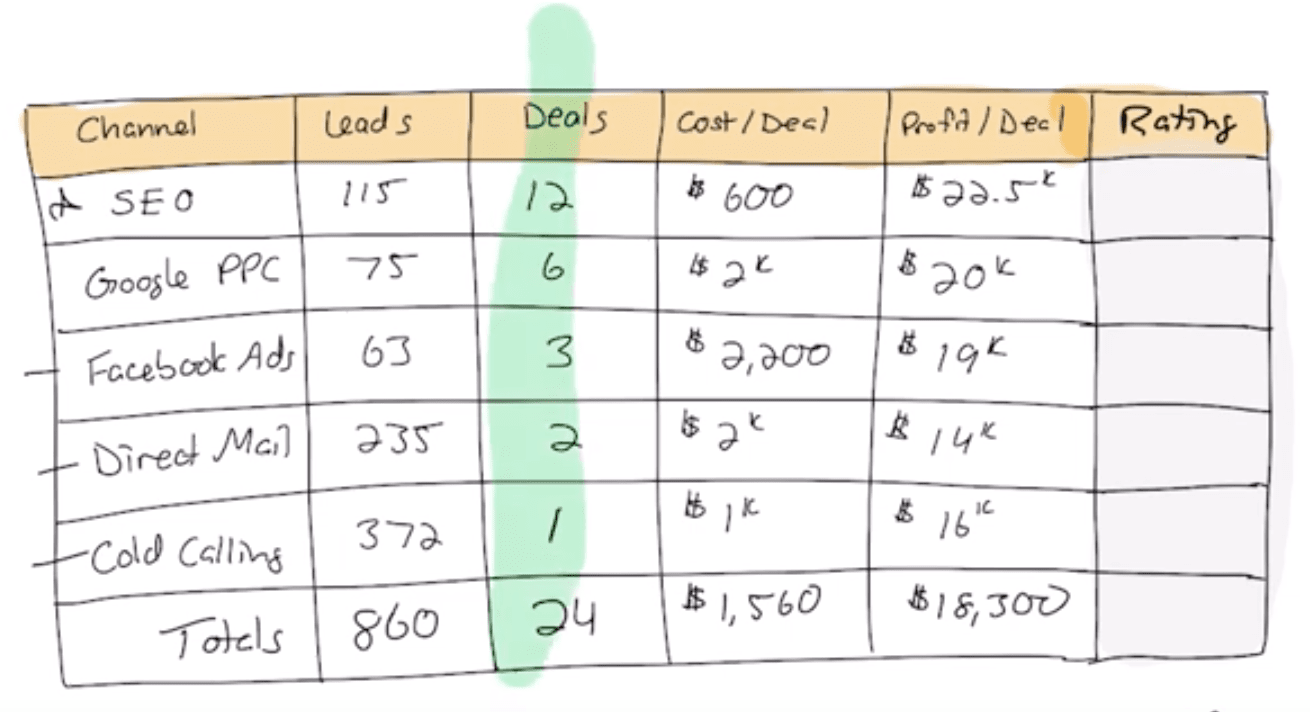
Now you might be saying, I don’t know how to track how many deals came from the channels.
Well, what we can do is if you’re using a system like Carrot, our system will actually tell you which leads came from SEO. It’ll tell you which leads came from a Facebook ad, or from a Google ad. It’ll tell you all of those things.
You can leverage a tool like Carrot to use our campaign tracking links or to use our lead source tool, and it’s going to tell you all that.
Now you’ll be able to know which leads and deals came from direct mail and cold calling because you want to use a different tracking phone number with each one of those marketing methods.
You can always say if anyone called from this phone number, it’s from my direct mail, so you can track the leads and deals.
Okay, now what I want you to do is dive even deeper.
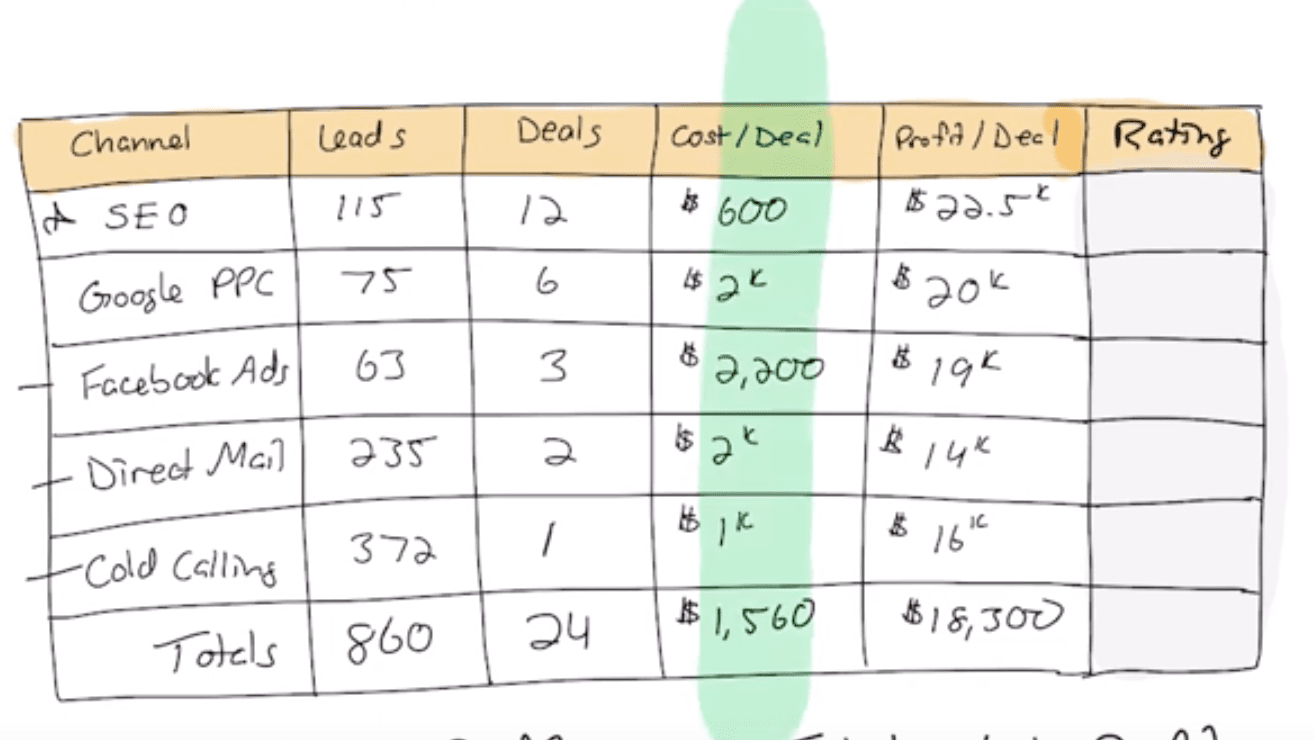
If you’re looking at this going, man, I don’t have this data.
What I want you to know is number one, it’s simple data to track so you can get it, but number two, this is critical data if you want to grow your business, work less, make a greater impact.
With each one of the channels, say, I’ve got 115 leads at the SEO this past year, 12 deals out of it. How much did you invest in doing SEO that year? Did you pay someone to do it? Did you do it yourself?
Just take the entire amount of money you invested in the SEO that year and divide it by the number of deals that you did. In this case, we’re just going to say it was about $600 a deal, which was the average cost when we took that amount.
If it was Google pay-per-click or direct mail same thing, take the entire cost of what you spent on direct mail this year, Google pay-per-click this year, or cold calling, or whatever it is, and then divide it by the number of deals you got to come up with your cost per deal.
This can be an important number.
Next, it’s the profit per deal. Do the same thing. Look at the lead sources. What were the profits on those?
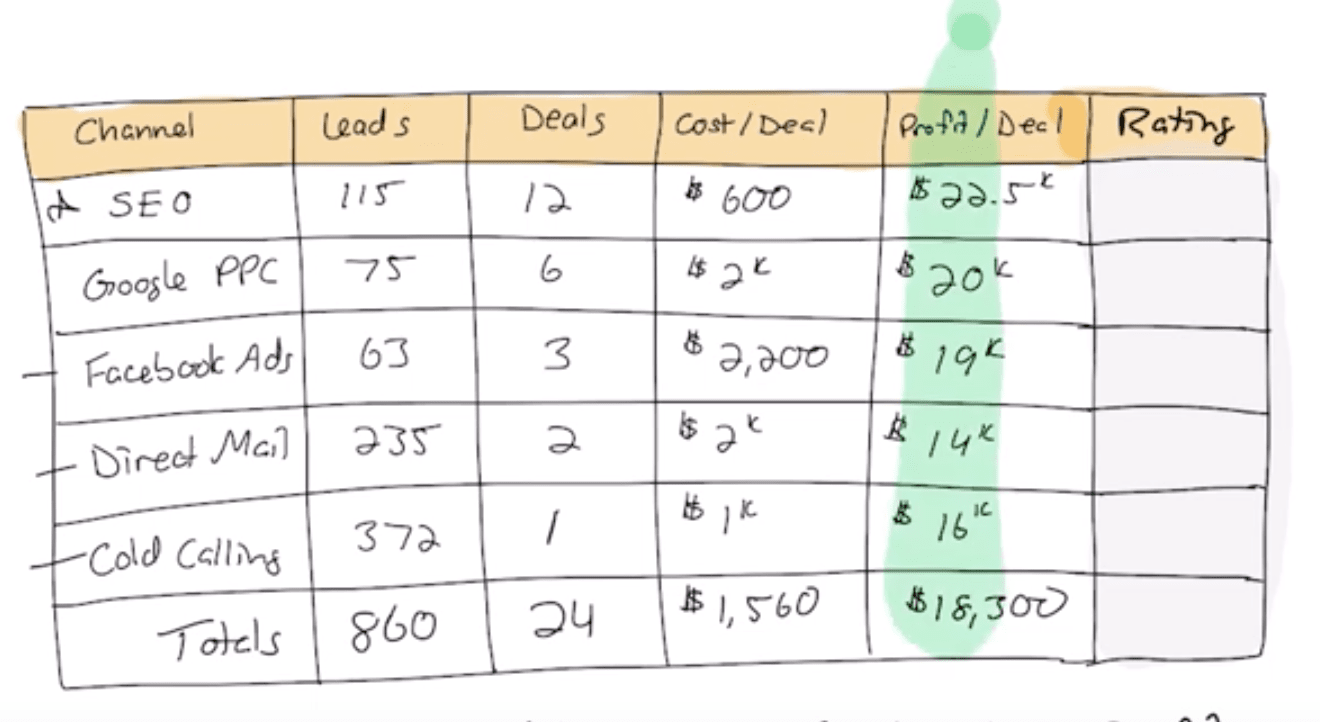
What were the total profits for the year for that channel, divided by how many deals you did, and fill out the profit per deal column.
We’re going to end up coming up with these numbers down here in this section down here which is… what was our total profit for the year?
If we add those up, our total gross profit in this example is about $439,000.
If we take out the cost for those deals, let’s say it was about $401,000. We netted $401,000, that’s amazing. That’s a huge huge year.
If your goal is $750,000, and we currently brought in about $439,000, the difference between those two numbers is $348,000, about $350,000.
That’s the Delta we’re trying to make up in this next year with our plan.
I’m going to show you guys exactly how to do that in about three to five more minutes in this video.
The next step I want you to take here, is with each one of your channels, now the way that we decide what we need to do in the year ahead, is we look at each channel and we ask ourselves, let’s kind of give it a grade rating, an A through an F.
An A means we’re executing it insanely well, and there’s probably no room for growth in this channel. We’ve maximized the channel.
If you’re doing SEO, and you’re just in one market, and you’re dominating Google for all of your keyword phrases, you’re ranked number one in Google for all your keyword phrases, that’s probably going to be an A.
There’s probably not a lot of room for improvement there if you’re dominating ranking number one in Google for all of your phrases.
If you’re not ranking number one in Google for all of your phrases, you’re number six, number seven, number eight, you might be getting a couple of leads here or there, maybe that’s a C.
Okay, give yourself whatever that rating is. Do the same thing with all of those.
I’m just going to make up some numbers here. Let’s say we’re a B with Google PPC. It’s working pretty good.
Let’s say direct mail, we’re a D on that, we tested it out, but we’re not really doing too great. Let’s say cold calling is an F, we got one deal, but man it wasn’t predictable. Let’s say, this is a B on the Facebook ads.
What we’re doing is we’re asking ourselves, where do we see an opportunity for growth? If it’s an A, we’re saying we’re doing the best we can possibly do, expanded it at the best we possibly could, there’s no opportunity for growth.
If it’s an F, it means we definitely haven’t maximized it, so it might be on the docket there okay.
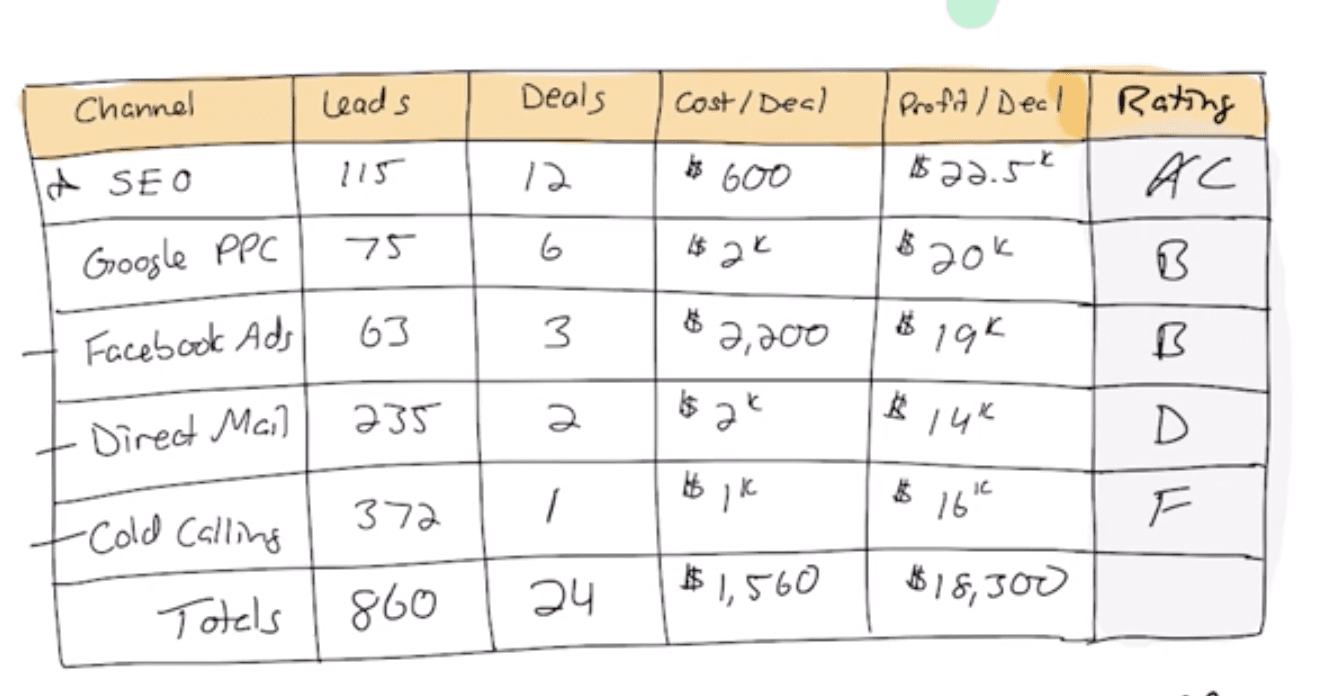
Now, let’s say Google pay-per-click and Facebook ads look awesome, and then I really want to get this direct mail thing working better, so I’m going to go I see an opportunity for growing Facebook or Google pay-per-click.
Let’s say direct mail number two, and Facebook number three. If I think that there’s a lot of room for growth and we have the skillset to do so.
Okay, I’m going to come down here now, with what we had just done with those ratings. We’re going to rate those out, and now we’re going to come up with some new goals for these.
Let’s say the Google PPC, what we had been doing in the past was 75 leads, let’s say we want to increase that now and grow that to 150 leads.
We want to double this so we can help to start to make up that Delta of about $350,000.
We know with Google pay-per-click that we’re closing about one in 10 leads into a deal that gives us $20,000.
That was six deals, now if we can double our Google pay-per-click if we see opportunity there, because we haven’t really stepped into it too much, or we can expand our keywords, that’s going to then take it to 12 deals.
Let’s say the cost per deal stays about the same, and the profit per deal stays about the same.
Now that’s going to make it to, rather than us bringing in about a $120,000 in Google pay-per-click that year, that’s going to bring in far more, that’s going to bring in, shoot, about $240,000 with Google pay-per-click that year.
I’m just going to delete that puppy and let’s make this the goal.
Let’s say $240,000 total is what we’re going to bring in, and we’re going to bring in $120K extra.
What we’re determining is how are we going to make up this Delta of $348,000 bucks? Well, now we’ve made up right there $120,000 of it with the Google side of it.
Now let’s look at Facebook. If we closed three deals last year from Facebook, and an average of about $20,000 profit per deal, how many more deals do we think we can get out of Facebook?
How many more leads do we think?
Can we double that? I don’t know. That’s for you to determine, go talk to someone who’s an expert, or you dive into it. Let’s say this doubles to six, and that goes from $60,000 to $120,000 now.
It goes from $60,000 to $120,000 now, and that is in total. So the extra, the Delta that we’re adding is another $60,000. $120,000 plus 60, that’s about $180,000. You guys know where I’m going with this, right?
Now let’s say direct mail. We see a lot of opportunities. We just did one test and we want to expand it out. Let’s say we want to take this and see if we can’t expand this to 10 deals this year. We want a 5x this year.
How many leads do we need to get the whole thing? I’m not going to do all the math here, but you guys see where I’m going with this.
The things that we want to focus on here, doing some quick behind-the-scenes math, is we want to figure out what channels do we need to expand it by, how much do we need to expand them to get to this number here? The $348,000 bucks.
We’re going to speed up through TV time, and now let’s assume that we had picked our three or four channels, we’d worked the numbers and we have a plan.
Let’s say the number one plan is the Google pay-per-click.
We worked the numbers. We say, I think there’s more opportunity there, maybe we can bump this to 200 leads, and maybe we can bump this to 15 deals, and that’s a couple of extra deals. That’s $160,000, $170,000 there. Bam we found out our plan.
Q1 now, I want you guys to do this.
Pick one new idea per quarter and two improvements per quarter. One thing that we oftentimes do is plan way too many projects. Just start one new thing per quarter, and two improvements per quarter.
This here might be a new idea of direct mail. We barely dabbled in direct mail. We’re going to launch a new direct mail campaign. That’s the big new thing we’re going to do this year.
Improvement number one is we’re going to expand Google PPC into the second market.
That’s our improvement. We’re going to expand there. Improvement number two might be expanding Facebook’s audience.
Then our goal, if our total goal is $348,000 in extra revenue, and our total goal for the year is $750,000. If we divide that out, how much money, how much revenue do we need to bring per quarter?
I’m just going to grab my fancy calculator here really fast and show you guys this last little thing and we’ll wrap this video, and you’ll have a plan essentially. $750,000 divided by four equals $187,000 a quarter. $187,500 a quarter; $187,500.
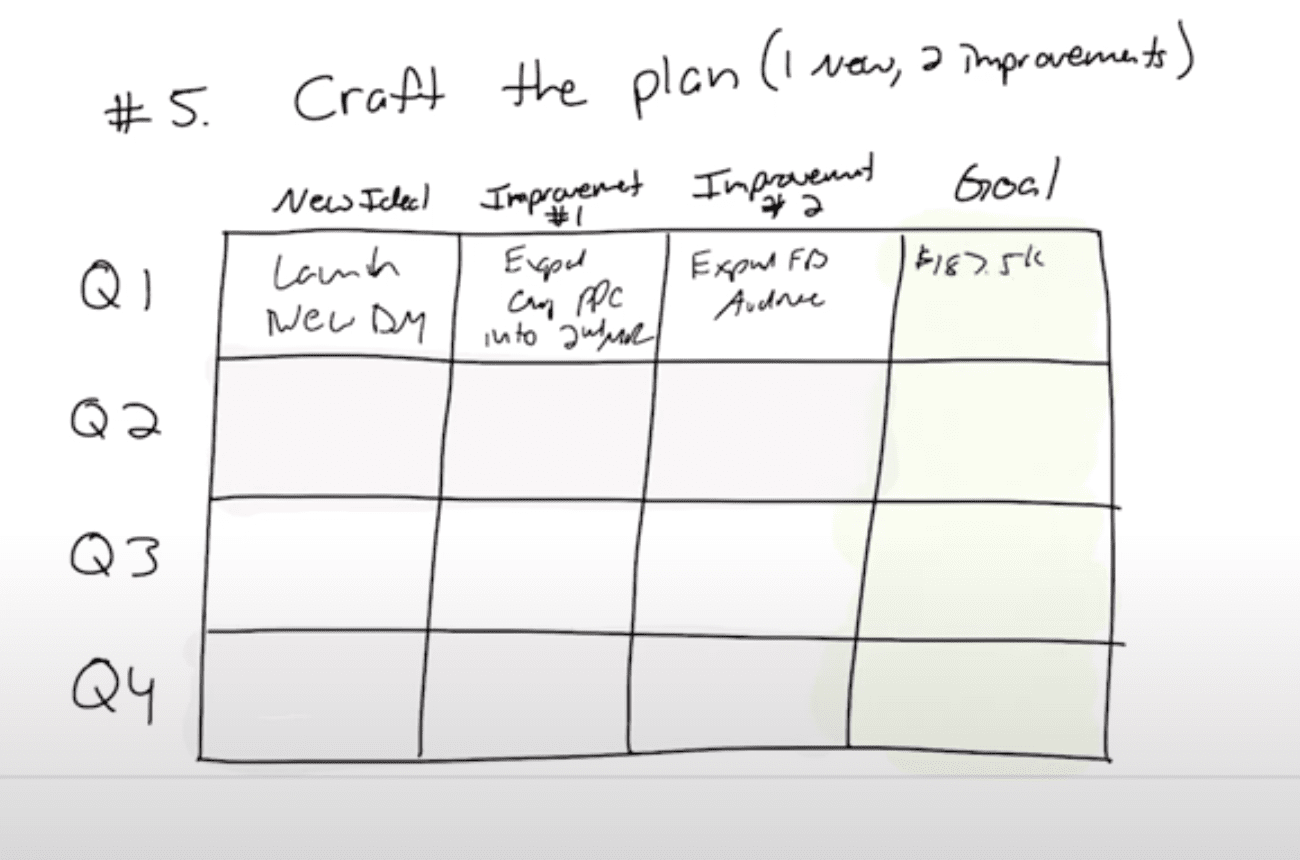
You don’t have to make these all exactly the same per quarter, you can make them so you ramp up or whatever you want to do. It’s your plan. Each quarter I’m going to be planning out this.
Then we say, hey our goal is $187,500 per quarter. You can break it down per month, and then you say, okay how much of this is going to come from our direct mail campaign?
How much of it’s going to come from our expansion of Google pay-per-click and Facebook ads.
Then spend the next 10, 15, 30 minutes going, if we did those in the first quarter, what do we need to do in the second quarter?
It might be launching something else new here. It might be hiring an employee over here because now you’re having more leads.
It might be now getting a dispositions manager or something like that. It might be adding Carrot in here is that big new project.
Then each quarter you pick two things you can improve, one thing you can grow on that’s brand new.
All right, guys. Let me recap this right now, block out about an hour to two hours possibly, as you’re heading into this next year, and this can help you get insane clarity in exactly what you need to do with your real estate marketing as an investor or agent.
The first thing is you pick your revenue goal for the year. The second thing is you break out a scorecard like this that I’m showing you on the iPad, and ask what is working and break it down by channel.
Dig into those numbers. If you don’t have them you really need them to grow.
Then figure out what your profits are, and ask yourself what’s the difference between my goal and what I did this past year?
Next, we need to say, what’s our greatest opportunity? We need to kind of grade our channels. An A is you’re doing the best you could possibly do, no more room for growth. An F is it’s terrible, and there might be room for growth.
Then craft your quarterly plan, one new thing, two improvements per quarter, and then map those to your scorecard, which would be bringing in $187,500 per quarter or whatever your number is.
Guys and gals, we’re going to have some amazing resources for you that are going to help you to do your planning better, that is going to help you to grow your business better.
If you’re looking to expand your evergreen marketing and buy back more of your time, go to Carrot.com/evergreen, and check out our latest webinar on this topic so you can step into evergreen marketing, win more leads that are the highest margin, highest profit deals while you’re stacking your marketing with your other channels.
Guys have an amazing rest of the week, plan your marketing, hit it hard, but buy back your time this year.
Thank you!
